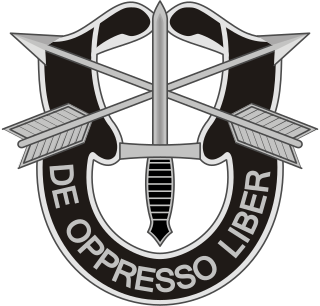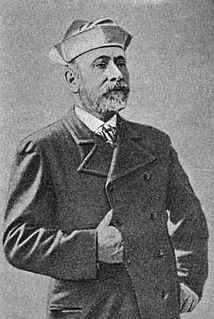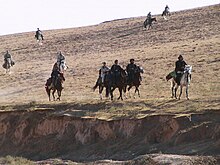An equestrian statue is a statue of a rider mounted on a horse, from the Latin eques, meaning 'knight', deriving from equus, meaning 'horse'. A statue of a riderless horse is strictly an equine statue. A full-sized equestrian statue is a difficult and expensive object for any culture to produce, and figures have typically been portraits of rulers or, in the Renaissance and more recently, military commanders.

Frederick William MacMonnies was the best known expatriate American sculptor of the Beaux-Arts school, as successful and lauded in France as he was in the United States. He was also a highly accomplished painter and portraitist. He was born in Brooklyn Heights, Brooklyn, New York and died in New York City.

De oppresso liber is the motto of the United States Army Special Forces.

Charles Henry Niehaus, was an American sculptor.

Pompeo Luigi Coppini was an Italian born sculptor who emigrated to the United States. Although his works can be found in Italy, Mexico and a number of U.S. states, the majority of his work can be found in Texas. He is particularly famous for the Alamo Plaza work Spirit of Sacrifice a.k.a. The Alamo Cenotaph, as well as numerous statues honoring Texan figures.

The Ulysses S. Grant Memorial is a presidential memorial in Washington, D.C., honoring American Civil War general and 18th United States President Ulysses S. Grant. It sits at the base of Capitol Hill, below the west front of the United States Capitol. Its central sculpture of Grant on horseback faces west, overlooking the Capitol Reflecting Pool and facing toward the Lincoln Memorial, which honors Grant's wartime president, Abraham Lincoln. Grant's statue is raised on a pedestal decorated with bronze reliefs of the infantry; flanking pedestals hold statues of protective lions and bronze representations of the Union cavalry and artillery. The whole is connected with marble covered platforms, balustrades, and stairs. The Grant and Lincoln memorials define the eastern and western ends, respectively, of the National Mall.

Anna Vaughn Hyatt Huntington was an American sculptor who was among New York City's most prominent sculptors in the early 20th century. At a time when very few women were successful artists, she had a thriving career. Hyatt Huntington exhibited often, traveled widely, received critical acclaim at home and abroad, and won multiple awards and commissions.

John Cassidy was an Irish sculptor and painter who worked in Manchester, England, and created many public sculptures.

Thomas Thornycroft was an English sculptor and engineer.

Robert Temple Summers II, is an American artist, in Cleburne, Texas. Summers, who works as a painter and sculptor, has created prominent bronze works displayed in places such as the Texas Ranger Hall of Fame and Museum, the Dallas Pioneer Park the Loews Anatole Hotel, Fair Park, Los Angeles International Airport, and Plano Texas' Baccus Plaza.

Eugene Daub is an American contemporary figure sculptor, best known for his portraits and figurative monument sculpture created in the classic heroic style. His sculptures reside in three of the nation's state capitals and in the National Statuary Hall in the United States Capitol. His work appears in public monuments and permanent collections in the United States and Europe.

Francis Asbury, also known as the Francis Asbury Memorial, is a public equestrian statue, by American artist Augustus Lukeman, located at 16th Street and Mt. Pleasant Street, Northwest, Washington, D.C., in the Mount Pleasant neighborhood.

General Philip Sheridan is a bronze sculpture that honors Civil War general Philip Sheridan. The monument was sculpted by Gutzon Borglum, best known for his design of Mount Rushmore. Dedicated in 1908, dignitaries in attendance at the unveiling ceremony included President Theodore Roosevelt, members of the President's cabinet, high-ranking military officers and veterans from the Civil War and Spanish–American War. The equestrian statue is located in the center of Sheridan Circle in the Sheridan-Kalorama neighborhood of Washington, D.C. The bronze statue, surrounded by a plaza and park, is one of eighteen Civil War monuments in Washington, D.C., which were collectively listed on the National Register of Historic Places in 1978. The sculpture and surrounding park are owned and maintained by the National Park Service, a federal agency of the Interior Department.

Carl Wilhelm Daniel Rohl-Smith was a Danish American sculptor who was active in Europe and the United States from 1870 to 1900. He sculpted a number of life-size and small bronzes based on Greco-Roman mythological themes in Europe as well as a wide number of bas-reliefs, busts, funerary monuments, and statues throughout Denmark, the German Confederation, and Italy. Emigrating to the United States in 1886, he once more produced a number of sculptures for private citizens. His most noted American works were a statue of a soldier for a Battle of the Alamo memorial in Texas, a statue of Benjamin Franklin for the World's Columbian Exposition in 1893, a statue group in Chicago commemorating the Fort Dearborn Massacre, and the General William Tecumseh Sherman Monument in Washington, D.C.
Angela Conner FRSS is an English sculptor who works in London. Conner has exhibited internationally and has large scale sculptures in public and private collections around the world.

Torleif Severin Knaphus was a Norwegian-born artist and sculptor in Utah, primarily known for sculptures for and about The Church of Jesus Christ of Latter-day Saints.

America's Response Monument, subtitled De Oppresso Liber, is a life-and-a-half scale bronze statue in Liberty Park overlooking the National September 11 Memorial & Museum in New York City. Unofficially known as the Horse Soldier Statue, it is the first publicly accessible monument dedicated to the United States Special Forces. It was also the first monument near Ground Zero to recognize heroes of the September 11 terrorist attacks.

Tina Allen was an American sculptor known for her monuments to prominent African Americans, including Frederick Douglass, Sojourner Truth, and George Washington Carver.
Jim Reno (1929–2008) was a bronze sculptor who focused his artistic abilities on western themes and famous horses, such as Secretariat. Reno's most notable sculpture is titled Secretariat—31 Lengths which is on display at the National Museum of Racing at Saratoga Springs, New York. He was also commissioned in 1973 by Secretariat's owner Penny Chenery (Tweedy) to sculpt a life-size bronze of the horse for the Kentucky Horse Park in Lexington, Kentucky. Reno also sculpted Dash For Cash, cattleman Charles Goodnight, Comanche Indian Chief Quannah Parker, and many other depictions of legendary people and horses.

Roger Noble Burnham was an American sculptor and teacher. He is best remembered for creating The Trojan (1930), the unofficial mascot of the University of Southern California.



















